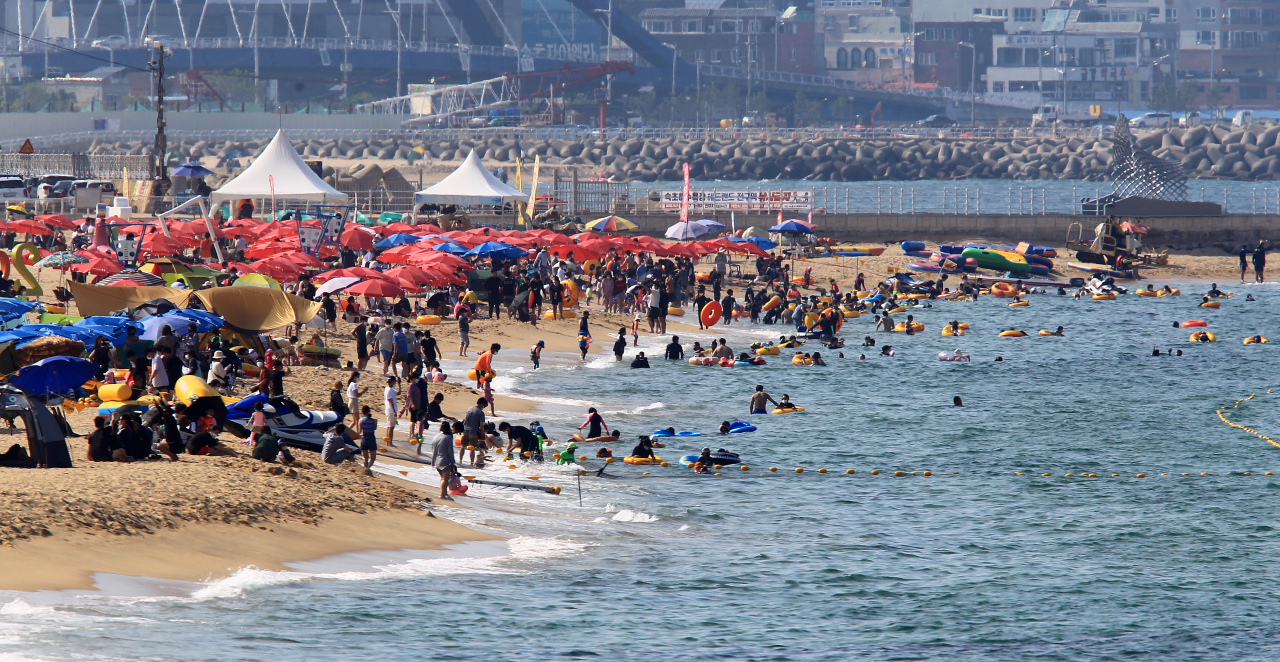 |
Sokcho Beach on the east coast is crowded with vacationers on Sunday. (Yonhap) |
Local governments in charge of antivirus measures at popular summer vacation destinations are on high alert for a massive influx of vacationers from the greater Seoul area and other regions hit by a surge of COVID-19 cases.
South Korea's daily new coronavirus cases have been in excess of 1,500 in recent days, with the capital area accounting for approximately three-fourths of the total.
Fearing that increased tourist arrivals at famous beaches and mountains nationwide will further fuel the spread of the coronavirus, local governments are moving to beef up their quarantine efforts.
In a related preemptive move, 10 of 14 metropolitan cities and provinces outside the capital area, including Busan, as well as Gangwon and Jeju provinces, raised their social distancing rules to Level 2, the third-highest in a four-tier system, Thursday.
Under Level 2, private gatherings of nine or more people are banned and a midnight curfew is imposed on restaurants, cafes and many other multiuse facilities. The capital area is now under the toughest restrictions of Level 4.
Some local governments, including Jeju, are reportedly mulling over a further upgrade of their social distancing level in time for the nation's peak summer vacation season between mid-July and mid-August.
The provincial government of Jeju, the nation's most popular tourist destination, visited by more than 1 million people every month since April, is moving to raise its social distancing scheme to Level 3 to cope with a recent surge in COVID-19 cases.
Over the past week, the average daily number of new confirmed cases on Jeju Island is 18.42, which exceeds the Level 3 criteria. In the case of Jeju with a population of 700,000, Level 3 is applied when the daily new cases top 13. Under Level 3, private gatherings of five or more are banned and a 10 p.m. curfew is imposed on restaurants and cafes.
Exceptionally, the Jeju government has ordered a shutdown of all 1,356 entertainment facilities in the province, as adult entertainment establishments have reported 58 COVID-19 cases this month alone. It has also introduced body temperature stickers to check for fevers of swimmers at 12 designated beaches, while visitors to beach changing rooms and convenience facilities are required to submit either a QR-code based entry log or a handwritten one.
The city government of Busan, another popular summer vacation destination on the southeastern coast, has also stepped up quarantine efforts at its seven public beaches.
Eating and drinking are not permitted on Busan beaches from 6 p.m. to the next morning and wearing a mask is compulsory at all times, except when playing in the water. To that end, municipal officials will patrol beaches to enforce the anti-COVID-19 rules.
Gangwon Province, where many popular East Sea beaches are located, asks all visitors with suspected symptoms to be tested for the coronavirus at train stations, bus terminals and highway toll gates. It will also install temporary testing stations at nine large beaches beginning next Thursday.
In addition, congestion traffic lights and entry reservation systems will be introduced to 83 east coast beaches to disperse vacationers, and gatherings will be prohibited there after 7 p.m.
Gangneung, an east coast city 240 kilometers east of Seoul, is pushing to raise its social distancing posture to Level 3 to cope with recent surges of COVID-19 cases.
The central province of North Chungcheong, home to a number of famous mountain valleys popular among summer vacationers, also said it will strictly enforce social distancing and quarantine rules, including mask wearing and temperature checks, for all visitors.
"We're worried about a large number of tourists coming from the capital area, where COVID-19 rapidly spreads, but we cannot prevent them from coming anyway," said an official in Goesan, a North Chungcheong county. "We'll ask all visitors to thoroughly follow quarantine rules and promptly respond to anybody with suspected symptoms." (Yonhap)








![[Today’s K-pop] Blackpink’s Jennie, Lisa invited to Coachella as solo acts](http://res.heraldm.com/phpwas/restmb_idxmake.php?idx=644&simg=/content/image/2024/11/21/20241121050099_0.jpg)